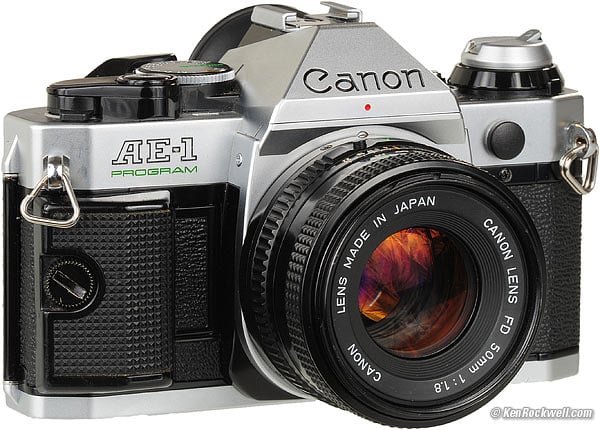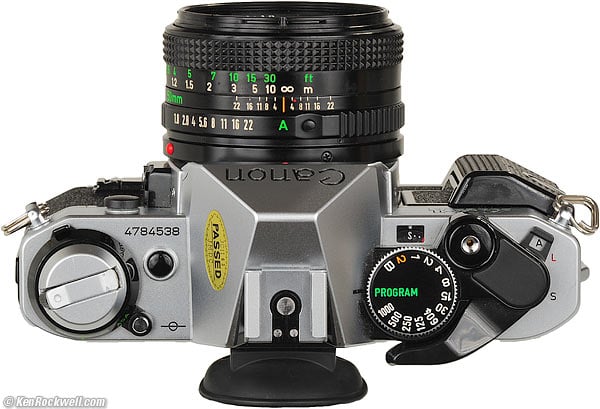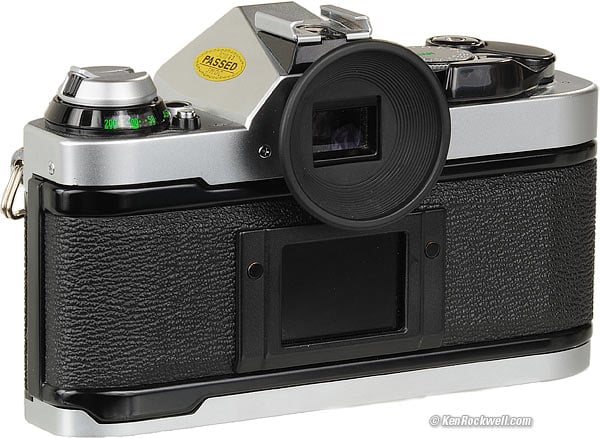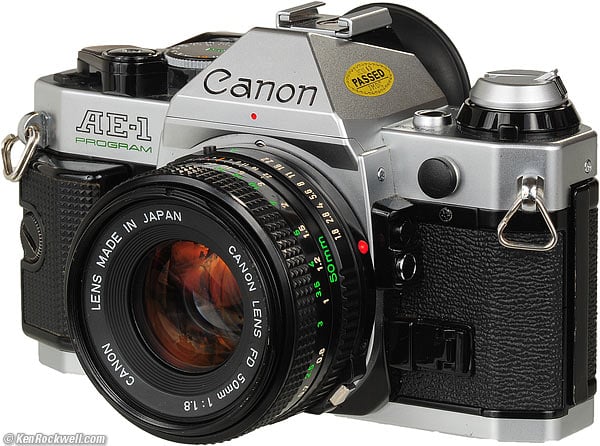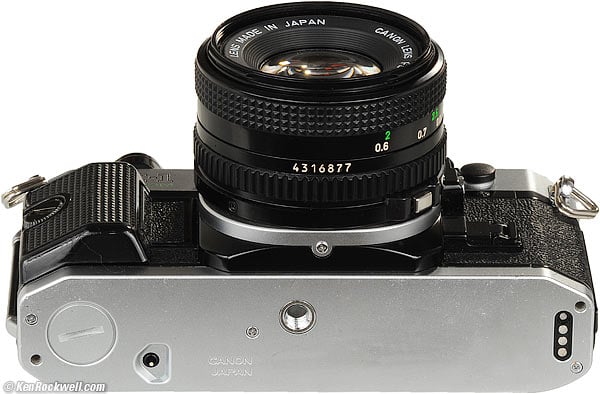Home Donate New Search Gallery How-To Books Links Workshops About Contact
Canon AE-1 Program
This is Photography! (1981-)
© 2009-2012 KenRockwell.com. All rights reserved.
Intro Specs Performance Usage Recommendations
Canon AE-1 Program, Action Grip and FD 50mm f/1.8 (20.6 oz/583g with battery and film but no lens; 26.5 oz/750g with this lens, about $50 used including lens). enlarge. My biggest source of support is when you use any of these links, especially this link directly to them at eBay, where I got this one (see How to Win at eBay) or to it at Adorama, when you get anything, regardless of the country in which you live. Thanks! Ken.
August 2012, July 2009 More Canon Reviews More Canon FD Reviews
How to Shoot the AE-1 Program Digitally
Introduction top
Intro Specs Performance Usage Recommendations
|
Adorama pays top dollar for your used gear. I use these stores. I can't vouch for ads below.
|
The Canon AE-1 Program is one of the most popular cameras of all time, and for very good reason: it is a spectacular camera.
Picking up where the original AE-1 (1976) and A-1 (1978) left off, the AE-1 program is a highpoint in all of photography's history.
The AE-1 Program is so highly regarded because it represents a high point of camera development. The AE-1 has every feature needed for great photos, and none of the junk features that have been added in the past couple of decades that makes most modern cameras unusable unless you carry — and read — a 300-page manual.
With the AE-1 Program, load film, compose, focus, and shoot. There are no menus, no custom functions, no WB settings, no settings banks, no raw or JPG, no nothing except great pictures.
Not only is the AE-1 Program a joy to use and makes great pictures, it has a huge, bright finder. Its finder is one of the largest, clearest and brightest finders ever made. Its finder is bigger than the finder of the Canon 5D Mark II, and much bigger and brighter than the finder of the Nikon D3X. I find the AE-1 Program's finder, with the 50mm f/1.8 lens, is brighter than the D3 or D3X with a 50mm f/1.4 lens. Hold one up to each eye at the same time (vertically) and you'll be amazed.
Exposure control is a dream. Set A on the lens and PROGRAM on the body, and just shoot. You'll see red aperture LEDs in the finder, arranged in an analog fashion one on top of the other, which is far more meaningful than the in-place digital displays of other cameras. With the AE-1 P, you can see exposure out of the corner of your eye based on the position of the lit LED (there is a custom LED for each full stop from f/1 to f/32).
Another great reason to shoot the AE-1 Program is the great range of FD lenses available inexpensively. For instance, the extraordinary FD 24mm f/1.4 L, FD 50mm f/1.2L and FD 85mm f/1.2 L sell used for tiny fractions of what today's EOS EF AF lenses cost. You can pick up this trio for less than a single new EF 24mm f/1.4 L II. FD lenses have been obsolete since the introduction of Canon's first AF EOS camera, the EOS 650, in March 1987.
I'm usually the only one excited by these old cameras, but the AE-1 Program is such a fantastic camera, even today, that some Leica dealers, like OC Camera, have a locked shelf full of nothing but AE-1 Programs for sale. They sell a lot of them, and why not? The Canon AE-1 Program offers all the simplicity of the LEICA, with far more flexibility, more accurate framing and viewing, and easier, faster and simpler shooting. Isn't this the core of LEICA photography?
Compatibility top
The AE-1 Program is compatible with manual-focus FD and New FD lenses.
The New FD lenses are the all-black ones as seen in the photos here, while the older FD lenses are the ugly ones with the chrome breech-lock rings.
Older Canon FL and non-FD lenses mount, but metering is stop-down only.
Top, Canon AE-1 Program, standard eyecup and FD 50mm f/1.8. enlarge.
Green means go. Set A and PROGRAM, and head out to win your next Pulitzer.
Specifications top
Intro Specs Performance Usage Recommendations
Type
Electronic auto and manual exposure, manual-focus 35mm SLR.
Finder top
Glass pentaprism.
Coated glass optics.
94% coverage.
0.83x with 50mm lens.
Split image surrounded by microprism surrounded by matte field.
Meter and Exposure top
TTL center-weighted.
Range: LV 1 ~ 18 with f/1.4 lens.
Modes: Program, shutter-priority and manual.
AE Lock? Absolutely.
ASA Range: 12 - 3,200.
Shutter top
Horizontal, 4-spindle electronic cloth focal plane.
Shock and noise absorbers.
Speeds (auto and manual): 1/1,000 ~ 2 seconds.
Flash Sync: 1/60 (X), M (for flashbulbs) at 1/30 and slower.
Cable Release: any standard threaded cable release.
Electromagnetic shutter release button.
Self Timer: 10 seconds.
Power top
One A544 6V battery, also known as 4LR44, 544, PX28, PX28L and 4SR44.
Alkaline and lithium versions all work great.
Battery Check: Press the black button by the rewind crank and serial number. 6 beeps per second is good, three beeps per second is low.
I left my camera ON ("A" position) for two years in the bag, and the battery is still fine. The real reason to turn it off ("L" position) is to prevent drain if something presses the shutter in your bag.
Size top
5-9/16" x 3-7/16" x 1-7/8."
141 x 88 x 47.5mm.
Weight top
26.480 oz. (750.7g) with FD 50mm f/1.8 lens, action grip, battery, rubber eyecup, film, and strap lugs, but no caps or strap.
25.700 oz. (728.6g) with FD 50mm f/1.8 lens, action grip, battery, rubber eyecup and strap lugs, but no film, caps or strap.
20.580 oz. (583.45g) with film, action grip, battery, rubber eyecup and strap lugs, but no lens, caps or strap.
19.800 oz. (561.35g) with action grip, battery, rubber eyecup and strap lugs, but no lens, film, caps or strap.
20.145 oz. (571.1g) with battery, rubber eyecup, film and strap lugs, but no lens, no action grip, caps or strap.
19.365 oz. (549.0g) with battery, rubber eyecup and strap lugs, but no lens,no action grip, film, caps or strap.
Specified as 20-5/16 oz (575g), stripped naked.
Canon AE-1 Program. enlarge.
Performance top
Intro Specs Performance Usage Recommendations
Ergonomics
The AE-1 Program excels at ease of use.
It just shoots. There is nothing to get in your way.
It's easy to get great shots.
I don't know about you, but I'm tired of missing shots because I had the wrong AF zone selected on my DSLR, or the camera wouldn't fire because its AF wasn't happy. With the AE-1 Program, you never miss a shot due to camera hiccups.
With the Canon AE-1 Program, you can think about making great pictures instead of
masturbating another camera's menu system.
Pardon my language, but if someone landed from Mars and saw someone looking down into their lap while rhythmically pressing something again and again and again, what else would it look like? A man from Mars would know that no Earthling would be dumb enough to use a camera that requires seven button pushes just to recall a settings bank with more settings he recorded earlier.
By the time most people get their white balance and ISO set, you've shot a roll of fantastic photos on your AE-1 P.
There is only one dial on the AE-1P, its shutter-speed and mode dial. It is easy to flip it with one fingertip.
The film counter and ASA dial are more legible than most manual-focus cameras.
The film can be wound in one easy stroke, or several smaller strokes.
The frame counter is red at 1, 20 and 36. It isn't red at 24; 24 is silver just like all the other numbers. It's numbered at every even number starting from 4 through 38 (yes, 38); before that, it's marked at S and 1 with dots for ever other.
AE Lock? Just press a button. Focus before locking the exposure, because it takes a contortionist to hold the AEL button while focusing.
Exposure compensation is via resetting the ASA dial as needed, which of course requires taking your eye from the finder. Use the AEL button for speed.
Exposure Accuracy top
It's right-on, especially with slides.
I'm impressed; shoot Velvia 50, and it works great in Program mode. Bravo!
There is no Matrix or evaluative system; you have to know how to compensate and use the exposure lock.
There is no spot or heavy center-weight for backlight; just get closer and lock the meter.
Finder top
The finder is exquisite. It is big, bright and sharp.
It is bigger than the EOS 5D Mark II, the EOS 620, and way bigger than a Nikon D3X.
The split-image rangefinder is very advanced. It optimizes itself for any speed lens. It doesn't black-out with slow lenses as they do on Nikon cameras.
The matte field is optimized for lenses of about f/2.5 and faster. Faster lenses won't actually show their shallower depths-of-field.
Flash top
Flash is primitive. In a few years, the EOS 650 will take Canon's flash system decades ahead of the AE-1 Program.
For the AE-1 Program, you're stuck with 1/60 sync speed, and no TTL control.
All you get for automation, with the right flash like the 011A, 133A, 155A, 166A, 177A, 188A, 199A, 533G and 577G is that the camera will set the shutter to 1/60 and set the lens to the correct auto aperture for the non-TTL flash, presuming you set the right ASA on the flash.
The guide number at ISO 100 for the 155A flash is 56' or 17 meters. At ASA 25, it's 28' or 8.5 meters.
Film Economy top
39 perfect frames on a roll of 36, presuming you shoot the leader as I do.
Power top
The battery is rated for about a year of use.
I never turn off my AE-1 Program; I leave it at A for instant shooting any time. I've left it at "A" for two years, and my battery is still fine.
Oddly when I did get a low battery signal (slow beeping when you press the battery test button by the rewind crank), that A544 battery tested as 60% on my ZTS MBT-1 tester.
Durability and Weaknesses top
The only two typical weaknesses are the film-door foam rubber turning to goo, and the lubrication of the aperture control gears drying up and the AE-1 Program making scary squealing sounds as it takes a picture.
The goo is easy for any camera repair place to replace.
The squealing is easy for a store to fix by spraying it with more lube, but that only makes it go away for a little while. You really want to have it disassembled, cleaned and relubricated properly instead of having more lube sprayed all around to make the squeal go away long enough to sell it to you.
Even if it squeals, it still works OK, even if it takes a moment for the picture to take after you press the shutter.
For repair, I've gotten great results from both Steven Swerington (Camera Clinic) and OC Camera as listed on my Repairs page. Each of them is very familiar with the AE-1 Program; heck, each of these guys could repair them in their sleep.
The top and bottom covers are heavy chrome-plated plastic. It looks like metal because it is, and it's as light as plastic, because it is. The covers can take quite a beating and keep on working.
Canon AE-1 Program. enlarge.
Usage top
Intro Specs Performance Usage Recommendations
All you really need to do is load film, wind, and shoot.
You get Program if you set the lens to A and the camera to PROGRAM.
Program means that the AE-1 Program's onboard computer is programmed with human intelligence to select the aperture and the shutter speed for you exactly as a seasoned professional photographer would for almost every situation. That's why the P mode is now more correctly called "Professional" mode. With a computer replicating the exact settings of seasoned professionals, but about 30 times as fast, you can shoot better, faster, more accurately and longer than any of those pros could do manually.
The finder shows the selected aperture, and the program always follows my favorite standard, which is 1/250 at f/8, 1/125 at f/5.6, 1/60 at f/4, 1/30 at f/2.8 etc. This makes it trivial to know the shutter speed.
AE Lock is the top teeny black button above the silver-rimmed button on the side of the body by the lens, under the PC sync socket. The silver-rimmed button turns on the meter without locking it. The meter has no hang time, regardless of what button you tapped to turn it on, it turns off the instant you release it.
When it gets dim enough to need 1/30 or slower, the P in the finder blinks.
If the light is so dim that even a full 2-second exposure, the AE-1 Program's maximum, isn't enough, the largest aperture also blinks (typically f/2). Ditto if it's too brought: the smallest aperture value blinks (typically f/22). Easy.
You get shutter priority if you leave the lens A and set a shutter speed, after which the finder shows you the aperture chosen.
I wouldn't use the depth-of-field preview button. It only works with manually set apertures, and then only if the shutter is in a certain state of being wound or not. It's defective by design, since if you press it at the wrong time, your picture will be underexposed!
For manual, take the lens off A, and the finder shows you the aperture the camera's meter suggests. There is no in-finder display of the manually set aperture; the finder display always shows the aperture selected by the camera.
To change the battery, you have to remove the action grip.
Since the film winds around the take-up spool emulsion-side out, it's a bear to reload a partially-shot roll into an auto-loading EOS camera because it wants to curl the wrong way.
I leave the camera ON ("A" setting on switch) and it runs for years, no need to turn it OFF ("L" position). The reason for the "L," or lock, position, is to prevent accidental battery drain or shooting if it gets bumped while stored in a bag.
Bottom, Canon AE-1 Program and FD 50mm f/1.8. enlarge.
Recommendations top
Intro Specs Performance Usage Recommendations
Just get one, or if you want autofocus, get an EOS 620.
The more I learn after my over 40 years of photography, the simpler the camera, the more and better pictures I make, and have more fun doing it.
If you want digital Nirvana, just check the box to get your film scanned as it's developed in an hour.
You can get them cheap and take your chances over eBay, or buy one that actually works from a dealer like Adorama or OC Camera . OC Camera just happens to specialize in them and keeps a counter full of good ones in stock, so I'd get one from them.
I bought one over eBay, and by the time I paid to have it repaired and overhauled, I could have just bought one that works from a dealer. If using eBay, expect to have to go through one or two until you get one that works.
I prefer the AE-1 Program over the much older AE-1 because I prefer the additional option of Program exposure. You are always having to adjust the shutter when shooting with the original AE-1, while with the AE-1 Program, you just shoot.
I prefer the AE-1 Program over the older A-1 because the AE-1 Program handles so much better and faster. The A-1 adds an aperture-priority mode I don't use, but the A-1 is an ergonomic pain when it comes to trying to turn the combined multifunction aperture or shutter sped dial.
I prefer the AE-1 Program over the newer T90 because the AE-1 Program is so much smaller, lighter and easier to use. The T90 might have been hot if it had the 6-segment evaluative meter of the EOS 650, but no, the T90 has metering which is more complicated, but not smarter than, the AE-1 Program.
More Information
Canon's AE-1 Program and other TV ads (Japanese)
Canon AE-1 Program Digital: See spy photos here, here, here and here.
Help me help you top
I support my growing family through this website, as crazy as it might seem.
The biggest help is when you use any of these links when you get anything, regardless of the country in which you live. It costs you nothing, and is this site's, and thus my family's, biggest source of support. These places have the best prices and service, which is why I've used them since before this website existed. I recommend them all personally.
If you find this page as helpful as a book you might have had to buy or a workshop you may have had to take, feel free to help me continue helping everyone.
If you've gotten your gear through one of my links or helped otherwise, you're family. It's great people like you who allow me to keep adding to this site full-time. Thanks!
If you haven't helped yet, please do, and consider helping me with a gift of $5.00.
As this page is copyrighted and formally registered, it is unlawful to make copies, especially in the form of printouts for personal use. If you wish to make a printout for personal use, you are granted one-time permission only if you PayPal me $5.00 per printout or part thereof. Thank you!
Thanks for reading!
Mr. & Mrs. Ken Rockwell, Ryan and Katie.
Home Donate New Search Gallery Reviews How-To Books Links Workshops About Contact
